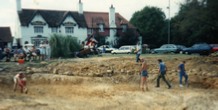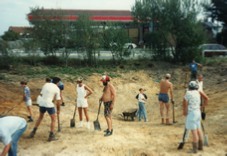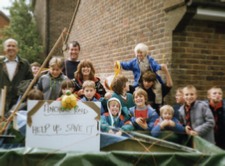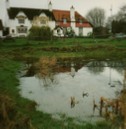

Web design © Graeme de Lande Long. Terms & Conditions.



Community Website
Scaynes Hill Village
On Tuesday 14th May about two dozen villagers enjoyed a humorous and informative illustrated talk about the Anchor Pond by Jerry Jeremiah, a well known and long time Scaynes Hill resident.



Anchor Pond - Past, present and Future
23 May Posted by Graeme de Lande Long
The meeting was held at the Inn on the Green, which although not yet officially re-opened, provided a very warm welcome complete with bar service, so many thanks to our new publican Luis. Jerry gave a brief introduction on the early history of the pond but went on with the aid of some memorable pictures to describe its refurbishment in 1990.
At that time the Parish Council were considering filling in the pond as it had become a messy area containing more rubbish than water, but the 'Scaynes Hill Four', consisting of Viv Jeremiah, Tony Watson, who ran the post office, Geoff Bennett and John Townsend, refused to accept the apparently inevitable and masterminded the campaign to restore the pond to its former glory. Projects like this do not happen without some passionate proponents and of course some money. The fund raising kicked off with Roger Wheatland driving round Scaynes Hill with his tractor and trailer loaded with children banging saucepans and asking for contributions. History doesn't relate how much was actually collected by this method but it certainly raised awareness of the issue and was followed by Geoff applying for and getting innumerable grants from companies and other bodies that were keen to promote such projects.
The pond would have originally been created as a dewpond, getting its water mainly from rainfall, although it was thought that before the road up Anchor Hill had been widened there had been a spring that also fed the pond; the road widening works were said to have diverted the spring. The purpose for the pond would have been for watering of animals, mainly those used for transport along the road. However, during excavations for the restoration a considerable number of pieces of coal were found so it is likely that it would also have served as a water supply to the steam traction engines that came into use later.
Work on the restoration started with Roger and his JCB roughly excavating the pond to its current profile, re-distributing the excavated material around the area as landscaping. The final profiling was all done by hand and many villagers helped in various degrees using spades, while on the deeper section the sandstone blocks forming a wall were cleaned and reinstated. However, before the final waterproofing was applied it was decided to hold a celebration hog-roast in the pond and being that so many had contributed time and money it was reckoned it would have to be a two pig affair. The day selected turned out to be the hottest that summer and due to its prominent position near the road many passers-by also stopped to join in so the car park was jammed and the pub practically drunk dry. Apparently it was quite a night to remember!
<< Back to News
Over the years since then the pond has become a little overgrown with some undesirable species such as willow, whose roots may have contributed to degradation of the lining since it no longer holds water as well as it used to. However, Steve Minter on behalf of LRPC was able to confirm that there was now an annual budget assigned for maintenance of the pond which would be carried out carefully by Gareth Main, a local landscaper with environmental credentials, to avoid interference with the great crested newts, a protected species known to inhabit the pond at certain times of year.




Start of fundraising on a trailer!
Excavation starts
Workers or posers?
The final waterproofing was achieved by using a large quantity of bentonite (a special clay that swells on wetting), which was placed over the entire pond area and wetted, before hoards of people in willies trampled it down 'puddling' the clay to form a dense waterproof layer. The pond was left to fill naturally with rainwater over the following months and planting of the area carried out, including reeds and other aquatic plants in the pond and a hedge to screen the pond from the road. The hedge of mixed native species has done very well and now provides an excellent habitat for wildlife.

Viv planting the hedge

The pond fills up
After the talk by Jerry the braver souls, including the children present, donned their wellies and wet weather gear to carry out some pond dipping under the guidance of Helen Hicks, who helped identify the variety of species found*, including a newt (but not a great crested one!). Those less willing to brave the rain remained drinking and chatting in the friendly atmosphere of the pub and all agreed it was a very successful event.
* Species identified were: common frog (adult); newt (smooth or palmate); mayfly nymph; damselfly nymph (lots); freshwater hoglouse; flatworm; freshwater shrimp; water beetle; great diving beetle larva; greater water boatman; pond skater; fly larva (unidentified?).